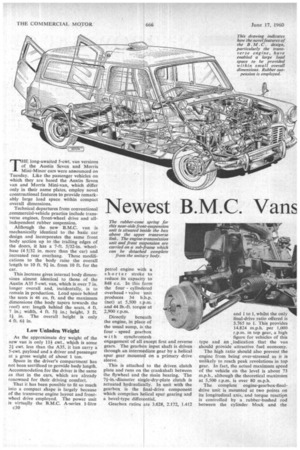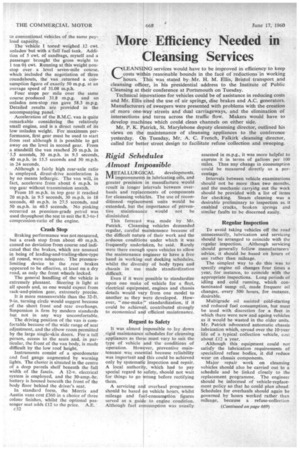Newest B.M.C. Vans Offer Space With Economy
Page 66

Page 67

Page 68

If you've noticed an error in this article please click here to report it so we can fix it.
THE long-awaited 5-cwt. van versions of the Austin Seven and Morris Mini-Minor cars were announced on Tuesday. Like the passenger vehicles on which they are based the Austin Seven van and Morris Mini-van, which differ only in their name plates, employ novel constructional features to provide remarkably large load space within compact overall dimensions.
Technical departures from conventional .commercial-vehicle practice include transverse engines, front-wheel drive and allindependent rubber suspension.
Although the new B.M.C. van is mechanically identical to the basic car design and incorporates the same front body section up to the trailing edges of the doors, it has a 7-ft. 5/32-in. wheelbase (4 5/32 in. more than the car) and increased rear overhang. These modifications to the body raise the overall length to 10 ft. 94. in. from 10 ft. for the Car.
This increase gives internal body dimensions almost identical to those of the Austin A35 5-cwt. van, which is over 7 in. longer overall and, incidentally, is to remain in production. Load space behind the seats is 46 Cu. ft. and the maximum dimensions (the body tapers towards the roof) are: length behind the seats, 4 ft. 7 in.; width, 4 ft. 54 in.; height, 3 ft. if in. The overall height is only
4 ft. 64 in. .
Low Unladen Weight
As the approximate dry weight of the new van is only 114 cwt., which is some 24 cwt. less than the A35, it can carry a 5-cwt. payload and a driver and passenger at a gross weight of about I ton.
Space in the driver's compartment has not been sacrificed to provide body length. Accommodation for the driver is the same as that in the cars, which are already renowned for their driving comfort.
That it has been possible to fit so much into a compact shape is largely because of the transverse engine layout and frontwheel drive employed. The power unit is virtually the B.M.C. A-series I-litre c30
petrol engine with a shorter stroke to reduce its capacity to 848 c.c. In this form the four cylindered overhead valve unit produces 34 b.h.p. (net) at 5,500 r.p.m. and 44 lb.-ft. torque at 2,900 r.p.m.
Directly beneath the engine, in place of the usual sump, is the four speed gearbox with synchromesh engagement of all except first and reverse gears. The gearbox input shaft is driven through an intermediate gear by a helical spur gear mounted on a primary drive sleeve.
This is attached to the driven clutch plate and runs on the crankshaft between the flywheel and the main bearing. The 74-in.-diameter single-dry-plate clutch is actuated hydraulically. In unit with the gearbox is the final-drive component which comprises helical spur gearing and a bevel-type differential.
Gearbox ratios are 3.628, 2.172, 1.412 and 1 to 1, whilst the only final-drive ratio offered is 3.765 to 1. This provides 14.824 mph. per 1,000 r.p.m. in top gear, a high figure for vehicles of this type and an ,indication that the van should provide attractive fuel economy.
The high ratio should also prevent the engine from being over-stressed as it is unlikely to reach peak revolutions in top gear. In fact, the actual maximum speed of the vehicle on the level is about 73 m.p.h., although the theoretical maximum at 5,500 r.p.m. is over 80 m.p.h.
The complete engine-gearbox-finaldrive unit is mounted at two points on its longitudinal axis, and torque reactipn is controlled by a rubber-bushed rod between the cylinder block and the scuttle. The complete unit shares a cornmon oil sump.
From the output flanges of the finaldrive unit, universally jointed shafts lead to the 10-in.-diameter front wheels. The inboard universal joints were specially developed for the vehicle and, although conventional in form, incorporate rubber bushes to provide extra articulation and reduce transmission snatch. The outer universal joints are the Rzeppa constantvelocity type.
The front wheels are carried on unequal transverse links and are located in the fore-and-aft plane by rubberbushed tie rods. Springing is provided by Moulton rubber-cone units between the upper links and the chassis. This suspension is progressive and requires no maintenance over what is claimed to be an exceptionally long life.
. Damping is by special Armstrong shock absorbers which, to suit the characteristics of the rubber units, give little resistance at gentle wheel deflections but, under rapid wheel movements, provide greatly increased effect.
Steering, which requires only 24 turns of the 15,1-in.-diameter two-spoke steering wheel from lock to lock, is by Cam Gears adjustable rack-and-pinion mechanism. The van turns between kerbs in 32 ft. 9 in.
The engine-transmission unit, radiator and complete front suspension assembly are carried on a sub-frame which is bolted to the main unitary body structure. Thus, for extensive overhauls, the corn
pletc front section can be withdrawn from the vehicle on the front wheels after releasing four bolts and detaching the various linkages.
Rear suspension is also independent, and it is to this feature and the elimination of a longitudinal Propeller shaft that the van owes its floor height of only 1 ft. 54 in. unladen. Unlike the froot suspension, the stub axles for the rear wheels are carried on single trailing radius arms, and the struts incorporating the rubber-cone springs are disposed horizontally.
A short lever connects the forward .end of each arm to the sprung strut which lies alongside it. Armstrong telescopic dampers are employed, and the upper ends of these protrude into the van body beside the rounded Wheelarches. Both rear-Suspension assemblies are carried on a separate sub-frame bolted to the unitary body.
The 10-in.-diameter four-stud wheels at front and rear carry 5.20-10 in tubeless tyres (a spare wheel is provided and this is situated beneath the front of the body floor) and 7-in.-diameter brake drums for the Lockheed hydraulic system.
Leading-and-trailing shoes with 14-in.wide -linings are fitted all round to give total lining area of 67.5 sq. in. Incorporated in the brake system is a device to limit the pressure applied to the rear brakes. This tends to prevent rear-wheel locking.
Brief acquaintance with one of the new vans over some 70 miles indicated that it lacks nothing in performance compared to conventional vehicles of the same payload capacity..
The vehicle I tested weighed 12 cwt. unladen but with a full fuel tank. Addition of 5 cwt. of sandbags, myself and a passenger brought the gross weight to 1 ton Of cwt. Running at this weight nonstop over a level seven-mile course, which included the negotiation of three roundabouts, the van returned a consumption figure of exactly 50 m.p.g. at an average speed of 31.08 m.p.h.
Four stops per mile over the same course produced 31.8 m.p.g. and an unladen non-stop run gave 58.3 m.p.g. Detailed results are provided in the accompanying panel.
Acceleration of the B.M.C. van is quite remarkable considering the relatively small engine, and is a direct result of its low unladen weight. For maximum performance, first gear must be used to start from rest although it is possible to get away on the level in second gear. From a standstill the van reached 20 m.p.h. in " 5.5 seconds, 30 m.p.h. in 9.5 seconds, 40 m.p.h. in 15.5 seconds and 50 m.p.h. in 24 seconds.
Although a fairly high rear-axle ratio is employed, direct-drive acceleration is by no means lethargic. The van will, in fact, accelerate from about 6 m.p.h. in top gear without transmission snatch.
From 10 m.p.h. in top gear it reached 20 m.p.h. in 9.5 seconds, 30 m.p.h. in 18 seconds, 40 m.p.h. in 27.5 seconds, and 50 m.p.h. in 40.5 seconds. No pinking occurred as premium-grade petrol was used throughout the test to suit the 8.3-to-I compression-ratio of the engine.
Crash Stop
Braking performance was not measured, but a crash stop from about 40 m.p.h. caused no deviation from course and indicated that the brakes, which are unusual in being of leading-and-trailing-shoe-type all round, were adequate. The pressurelimiting device to the rear brakes appeared to be effective, at least on a dry road, as only the front wheels locked.
The general handling of the vehicle is extremely pleasant. Steering is light at all speeds and, as one would expect from rack-and-pinion gear, extremely precise.
It is more manoeuvrable than the 32-ft. 9-in, turning circle would suggest because of the short front and rear overhangs. Suspension is firm by modern standards but not in any way uncomfortable.
The driving position of the van is comfortable because of the wide range of seat adjustment, and the elbow room permitted by the large single-skin doors. For a tall person, access to the seats and, in particular, the front of the van body, is made difficult by the low roof height.
Instruments consist of a speedometer and fuel gauge augmented by warning lights. The cluster is situated in the centre of a deep parcels shelf beneath the full width of the fascia. A 12-v. electrical system is employed, and the 30-amp.-hr. battery is housed beneath the front of the body floor behind the driver's seat.
In standard form, the Morris and Austin vans cost £360 in a choice of three colour finishes, whilst the optional passenger seat adds £12 to the price. A.E.
c:32
























































































































